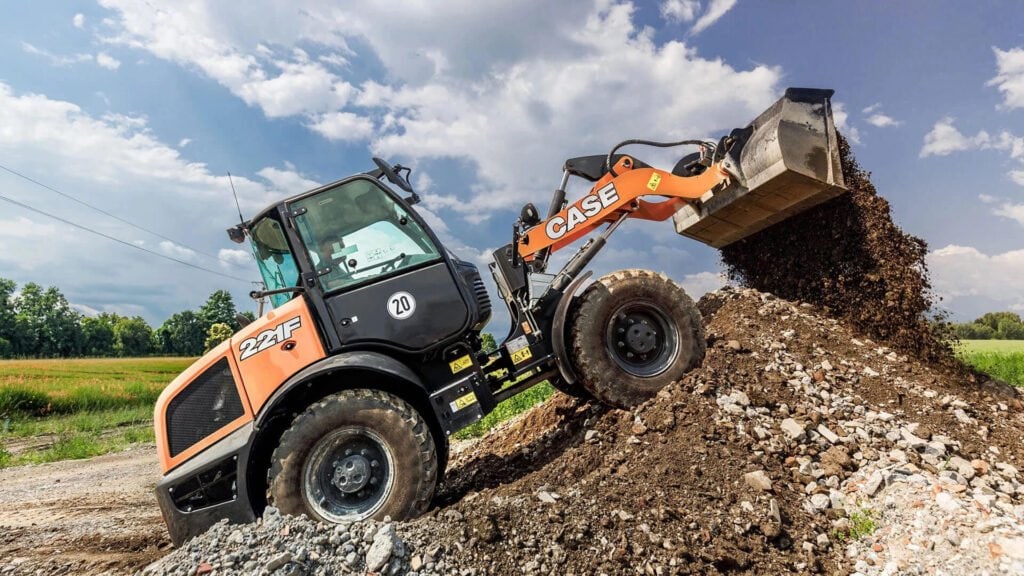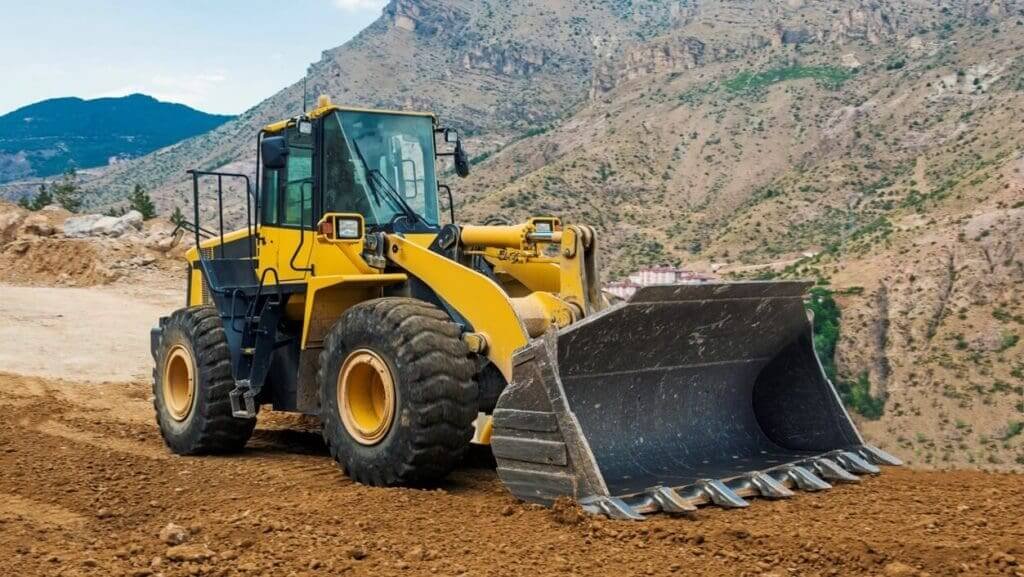Introduction: Identifying the Right Loader for Your Needs
Getting the wrong type of loader will cost you time, money, and the opportunity to get more work done. It’s easy to become overwhelmed because there are so many different types of loaders out there. Choosing the proper loader for the job is vital to getting the most work done in the least amount of time.
But how do you know which loader is right for your specific job?
In this guide, you’ll learn about the different types of loaders, what separates them from one another, as well as their best applications. By the time you’ve finished reading, you’ll know everything you need to decide which loader is the right loader versus one that will kill your productivity and performance.

1. Wheel Loaders
1.1 What Are Wheel Loaders?
A wheel loader is a powerful machine designed to handle materials for construction, mining, agricultural applications, or anything else you can think of. It has a big bucket mounted on the front to scoop, lift, and move things like soil, sand, or gravel.
1.2 Key Features of Wheel Loaders:
🟠 Fast Travel Speed: The biggest advantage of a wheel loader over a tracked machine is speed. If you need to move across a large area on a regular basis, you want a wheel loader. If you don’t, you’ll hate yourself for buying one.
🔵 Large Bucket Capacity: Wheel loaders are extremely efficient at moving bulk materials because you can load so much more so much faster.
🟢 Versatile Attachments: In addition to the bucket, you can put forks, a grapple, or a snowplow on a wheel loader to do different kinds of jobs.
1.3 Common Applications for Wheel Loaders:
- Material Transport: Wheel loaders are ideal for quickly moving aggregates, soil, and other bulk materials.
- Debris Cleanup: Frequently used in demolition sites for clearing debris.
- Pavement Maintenance: Their rubber tires make them suitable for working on asphalt or concrete.
1.4 Pros and Cons of Wheel Loaders:
| Característica | Benefit | Limitation |
|---|
| Fast Operation | Improves efficiency in material transport | Less stable on muddy or uneven terrain |
| Large Bucket Size | Reduces the number of trips required for loading | Requires more storage space when not in use |
| Attachment Compatibility | Expands machine functionality | Tires may wear faster on rough surfaces |
1.5 Common Models of Wheel Loaders
What are wheel loaders used for? They are excellent at hauling large amounts of material across a farm, construction site, or any of the dozens of work places that have been designed to use wheel loaders. Wheel loaders are equipped with a large bucket on the front. They are excellent at moving a lot of material and are known for high productivity and versatility:
| Modelo | Manufacturer | Potencia del motor | Capacidad del cucharón | Solicitud |
|---|
| CAT 980M | Oruga | 287 hp | 4,5 m³ | Heavy material handling, mining |
| Komatsu WA500-8 | Komatsu | 326 hp | 4.8 m³ | Construction, mining |
| Volvo L90H | volvo | 270 hp | 3.5 m³ | Roadwork, material handling |

2. Skid Steer Loaders
2.1 What Are Skid Steer Loaders?
What is a skid steer loader? It’s a small, yet powerful loader that can spin in place. Considering its size and versatility, it can be a beautiful thing for you to have on your farm, in an arena, around a dairy, or in other locations where you need to get a lot done in a tight space.
2.2 Key Features of Skid Steer Loaders:
🟠 Diseño compacto: Their small frame enables them to navigate narrow pathways and confined spaces.
🔵 Zero Turning Radius: Skid steer loaders can turn 360 degrees in place, maximizing maneuverability.
🟢 Versatile Attachments: Compatible with augers, trenchers, sweepers, and grapple buckets.
2.3 Common Applications for Skid Steer Loaders:
🟠Landscaping Projects: Ideal for grading, leveling, and tree planting.
🔵Demolition Work: Equipped with hydraulic breakers for efficient structure demolition.
🟢Snow Clearing: Their compact design allows them to efficiently clear snow in parking lots, walkways, and driveways.
2.4 Pros and Cons of Skid Steer Loaders:
| Característica | Benefit | Limitation |
|---|
| Tamaño compacto | Excellent for confined spaces | Limited load capacity |
| Pivot Steering | Allows precise maneuvering | Can cause ground disturbance on soft surfaces |
| Archivos adjuntos versátiles | Expands its use in diverse projects | May require frequent hydraulic maintenance |
2.5 Common Models of Wheel Loaders
Wheel loaders are ideal for transporting large volumes of materials across construction sites, mines, and quarries. These loaders are equipped with a front-mounted bucket and are known for their high productivity and versatility. Below are a few commonly used models:
| Modelo | Manufacturer | Potencia del motor | Capacidad del cucharón | Solicitud |
|---|
| CAT 980M | Oruga | 287 hp | 4,5 m³ | Heavy material handling, mining |
| Komatsu WA500-8 | Komatsu | 326 hp | 4.8 m³ | Construction, mining |
| Volvo L90H | volvo | 270 hp | 3.5 m³ | Roadwork, material handling |

3. Track Loaders
3.1 What Are Track Loaders?
Track loaders are big, powerful machines that have tracks instead of wheels. They offer much better traction and stability when the grass is wet, and, therefore, slippery. They’re also very handy on soft or muddy surfaces.
3.2 Key Features of Track Loaders:
🟠 Enhanced Traction: Tracks provide superior grip on unstable or rugged terrain.
🔵 Heavy-Duty Power: Track loaders excel at pushing, digging, and moving heavy materials.
🟢 Reduced Ground Pressure: Tracks distribute the machine’s weight evenly, minimizing surface damage.
3.3 Common Applications for Track Loaders:
🟠Excavation Work: Ideal for digging trenches, grading land, and earthmoving.
🔵Forestry Operations: Often used for logging and clearing dense vegetation.
🟢Wet or Muddy Environments: Tracks prevent the machine from sinking in unstable ground conditions.
3.4 Pros and Cons of Track Loaders:
| Característica | Benefit | Limitation |
|---|
| Superior Traction | Ideal for muddy, sandy, or uneven surfaces | Slower travel speed on paved roads |
| Heavy Lifting Power | Suitable for demanding earthmoving tasks | Higher fuel consumption |
| Durable Tracks | Enhances machine longevity in tough environments | Tracks require frequent cleaning and maintenance |
3.5 Common Models of Track Loaders
Track loaders are built with continuous rubber tracks instead of wheels, offering enhanced stability and traction in uneven or soft ground conditions. They are well-suited for demanding applications in construction, forestry, and landscaping.
| Modelo | Manufacturer | Potencia del motor | Peso operativo | Solicitud |
|---|
| CAT 963K | Oruga | 174 hp | 17,820 kg | Excavation, forestry |
| Komatsu SVL95-2 | Komatsu | 95 hp | 5,675 kg | Heavy lifting, demolition |
| Bobcat T870 | Gato montés | 100 hp | 4,750 kg | Landscaping, material transport |

4. Backhoe Loaders
4.1 What Are Backhoe Loaders?
Backhoe loaders are versatile machines that combine a front-mounted loader with a rear-mounted backhoe arm. This dual design allows them to perform multiple functions efficiently.
4.2 Key Features of Backhoe Loaders:
🟠 Dual-Function Design: Combines digging, trenching, and material loading in one machine.
🔵 Compact Size: Easier to maneuver in urban environments compared to large excavators.
🟢 Wide Attachment Compatibility: Accepts breakers, rippers, and augers for diverse tasks.
4.3 Common Applications for Backhoe Loaders:
🟠Utility Trenching: Perfect for digging trenches for pipes, cables, and drainage systems.
🔵Road Maintenance: Often used for backfilling and leveling tasks.
🟢Landscaping Projects: Efficient for digging tree holes, moving rocks, and clearing debris.
4.4 Pros and Cons of Backhoe Loaders:
| Característica | Benefit | Limitation |
|---|
| Dual Functionality | Efficient for multitasking | Less powerful than dedicated excavators |
| Diseño compacto | Ideal for urban job sites | Limited bucket capacity |
| Wide Attachment Range | Versatile for construction and maintenance | May require specialized training for operation |
4.5 Common Models of Backhoe Loaders
Backhoe loaders are also referred to as loader backhoes, diggers, or simply backhoes. They are similar in appearance to farm tractors equipped with a front bucket or blade, but they are much more powerful and versatile. Backhoes are essential for a variety of construction applications, from digging holes to moving dirt to clearing obstacles from the job site.
| Modelo | Manufacturer | Potencia del motor | Capacidad del cucharón | Solicitud |
|---|
| JCB 3CX | JCB | 93 hp | 1.0 m³ | Roadwork, landscaping |
| CASE 570N EP | CASE | 75 hp | 1,3 m³ | Construcción urbana, trabajos de servicios públicos. |
| CAT 420F/IT | Oruga | 93 hp | 1.0 m³ | Utility work, excavation |

5. Compact Wheel Loaders
5.1 What Are Compact Wheel Loaders?
Compact wheel loaders are essentially mini-versions of the bigger wheel loaders, albeit with slightly less power and load capacity. These small machines have a great capacity for improvement and can also help you to get more active on processes.
5.2 Key Features of Compact Wheel Loaders:
🟠 Diseño compacto: Fits easily into narrow spaces without sacrificing power.
🔵 Efficient Fuel Consumption: Uses less fuel than larger wheel loaders.
🟢 Quick Attachment Switching: Enables rapid switching between buckets, forks, and grapples.
5.3 Common Applications for Compact Wheel Loaders:
🟠Residential Construction: Ideal for small-scale earthmoving and material transport.
🔵Agricultural Use: Efficient for moving hay, animal feed, and farm equipment.
🟢Municipal Maintenance: Frequently used for park maintenance, snow clearing, and road repair.
5.4 Pros and Cons of Compact Wheel Loaders:
| Característica | Benefit | Limitation |
|---|
| Small Size | Ideal for tight spaces | Limited bucket capacity |
| Eficiencia de combustible | Reduces operating costs | Less powerful than standard wheel loaders |
| Quick Attachment Change | Enhances versatility for multiple tasks | Requires more frequent tire inspection |
5.5 Common Models of Compact Wheel Loaders
Compact wheel loaders deliver the same performance as their larger counterparts but with superior maneuverability and a smaller footprint. As such, these loaders are incredibly valuable on space-constrained job sites or in urban environments.
| Modelo | Manufacturer | Potencia del motor | Capacidad del cucharón | Solicitud |
|---|
| CAT 906M | Oruga | 74 HP | 0.9 m³ | Landscaping, small-scale material handling |
| Bobcat L85 | Gato montés | 68 HP | 1.0 m³ | Agriculture, road maintenance |
| Volvo L20H | volvo | 64 HP | 0.8 m³ | Utility work, construction |

Conclusión
The right loader makes all the difference in getting the job done quickly and efficiently. Whether it’s the powerhouse of a wheel loader, the finesse of a skid steer, or the magic act of a backhoe loader, each machine serves its own unique purposes. Evaluate what you need to do, where you’re doing it, and what materials you need to handle. That will tell you which machine will work best for you.